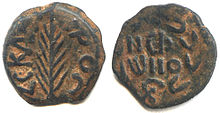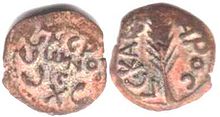- Roman Procurator coinage
-
Roman Procurator coinage were coins issued by the Roman Procurators and Prefects of the province of Judea between 6 - 66 AD. They minted only one denomination and size, the bronze prutah.
Not all of the Procurators issued coinage. Those that did were Coponius, Marcus Ambivulus, Valerius Gratus, Pontius Pilate, Antonius Felix and Porcius Festus, who between them issued a total of 19 different coins.[1] The last three Procurators Lucceius Albinus, Gessius Florus and Marcus Antonius Julianus didn't issue any coins as the tidings of the First Jewish-Roman War was in the air and the leaders of the revolt started issuing their own coins.
Contents
Coponius
Coponius was the first Roman Prefect of Judaea, being appointed in 6 AD when Herod Archelaus, the son of Herod the Great, was deposed and banished to Gaul by Augustus. Coponius depicted the palm tree bearing two bunches of dates on his coinage, which previously had appeared only on extremely rare coins of Herod Antipas. The palm tree design was later used to represent Judaea on coins issued by the Jews during the First and Second Revolts, as well as later Roman-issued Judaean-related pieces.[2]
The obverse of Coponius's coins show an ear of barley. The representation of palm trees and barley was done out of sensitivity to Jewish belief not to depict a living creature, and especially not a human being, on their coinage; hence, there is no portrait of the Emperor Augustus on these coins.[3] However, the inscriptions on the coins clearly proclaim that Judaea was occupied by Imperial Rome; hence, the Greek letters surrounding the barley read: [K]aisa-ros ["of Caesar"] with the date, also in Greek letters, under the palm.[4]
Marcus Ambivulus
Marcus Ambivulus was the Prefect of Judaea from 9 - 12 A.D. He issued a coin for each of the three years of his rule. Like those issued by Coponius, the coins of Ambivulus depicted a palm tree bearing two bunches of dates and an ear of barley.
Valerius Gratus
Valerius Gratus was Prefect of Judaea under the Emperor Tiberius. Gratus issued several different types of coins in as many years. The symbols represented on his coins included palm branches, lilies, cornucopia, grape leaves and amphorae.[5] His coins showed Caesar’s title within a wreath, and the Emperor’s name 'TIB' or his mother, Julia (IOYLIA), and the year of his reign above two cornucopiae.[2]
Pontius Pilate
The bronze coins (or 'prutah') issued by Pontius Pilate between 26 - 36 AD are of especial interest to Christians and Jews because of his connection with Jesus Christ and his involvement in Jewish history. The evidence of his coinage and the Pilate inscription found at Caesarea seems to reveal that Pontius Pilate as Prefect was determined to promote a form of the Roman religion in Judaea regardless of whether this was offensive to the Jews. Unlike those of his predecessors, the coinage issued by Pilate depicts Roman symbolism connected with the imperial cult such as the simpulum and lituus.[6] However, it has been argued that if Pilate was deliberately trying to offend the Jews he would have put the head of the Emperor on the obverse of his coinage.[7] Instead, he depicted three ears of barley. A third type showed crossed palm branches and a wreathed inscription.
The lituus was the wand of an augur, and was used to interpret natural phenomenon such as lightning flashes, the flight of birds, etc. The simpulum was a ladle used to make libations during sacrifices and was a common symbol of the Roman priesthood.[6] These symbols were guaranteed to offend Jewish religious sensibilities being placed on coinage that they would have to handle on a daily basis.
According to the Caesarea inscription, Pilate dedicated a Tiberieum to the deified Augustus. Philo wrote that Pilate was "...inflexible, merciless and obstinate...(and did not) wish to do anything that would please his subjects."[8] Josephus stated that Pilate set up shields, also associated with the Roman imperial cult, in honour of Tiberius in the Jewish Temple in Jerusalem, which also caused great offence to the Jews, who protested until they were removed.[9]
Antonius Felix
Felix was Procurator of Judaea under Claudius. His coins bear the names of Claudius, Julia Agrippina, Nero (as 'Caesar'), and Britannicus.[10] The obverse of his coins show two shields and two spears crossed, while the reverse shows a six-branched palm tree bearing two bunches of dates. The depiction of military arms on these coins would have been a constant reminder to the Jews that handled them that they were under the jurisdiction of Rome.
Porcius Festus
Procurator under Nero, only one known coin type was issued by Festus, the obverse of which features a palm branch and the Greek legend KAICAPO (Caesar), and the reverse NEPWNOC (Nero) in a wreath.
See also
References
- ^ David Hendin, 'Guide to Ancient Jewish Coins' numbers 635-653
- ^ a b [1] Coins from the Procurators on Jewish Virtual Library
- ^ Coponius - article by R. Gottheil & S. Krauss in the Jewish Encyclopedia
- ^ [2] Coponius on Virtual Religion website
- ^ Ancient Coin Collecting VI: Non-classical Cultures by Wayne G. Sayles. Pub. by Krause Publications (1999) pg 113
- ^ a b [3] Coins of Pilate on the Numismalink website
- ^ [4] Pilate coins on the Coinsite website
- ^ Philo of Alexandria, The Legatio ad Gaium, trans. with commentaries by E. Mary Smallwood (Leiden, 1961)
- ^ Flavius Josephus, 'Antiquities of the Jews', trans. by William Whiston, The Echo Library (2006)
- ^ Ancient Coin Collecting VI: Non-classical Cultures by Wayne G. Sayles. Pub. by Krause Publications (1999) pg 114
External links
- The Jewish Virtual Library
- Prutah exhibited at the Residence of the President of the State of Israel
- Valerius Gratus coin, found at Emmaus [5]
Categories:- Coins of ancient Rome
- Numismatics
- Currency lists
- Jewish history
- Jews and Judaism in the Roman Empire
Wikimedia Foundation. 2010.




